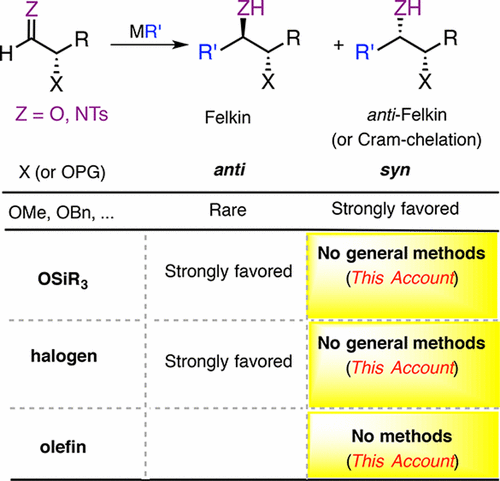Chelation-Controlled Additions to Chiral α- and β-Silyloxy, α-Halo, and β-Vinyl Carbonyl Compounds
Xinyuan Fan and Patrick J. Walsh*
aInstitute of Advanced Synthesis, School of Chemistry and Molecular Engineering, Jiangsu National Synergetic Innovation Center for Advanced Materials, Nanjing Tech University, 30 South Puzhu Road, Nanjing 211816, P. R. China
bRoy and Diana Vagelos Laboratories, Department of Chemistry, University of Pennsylvania, 231 South 34th Street, Philadelphia, Pennsylvania 19104-6323, United States
Abstract:The science and art of preventing and managing disease and prolonging life is dependent on advances in medicine, biology, and biochemistry. Many of these advances will involve interactions of small molecules with biological entities. As such, they will rely on the efficient synthesis of active compounds with very high stereochemical purity. Although enantioselective reactions are important in this regard, most stereocenters in complex molecule synthesis are installed in diastereoselective reactions. Perhaps the most well-known diastereoselective C–C bond-forming reaction is the addition of nucleophiles to carbonyl groups with α- or β-stereogenic centers. Diastereoselective additions of organometallic reagents to protected chiral α- and β-hydroxy aldehydes and ketones are described by either Cram chelation or Felkin–Anh models, which are protecting group (PG)-dependent. Small PGs (X = OMOM, OBn, etc.) favor Cram chelation, wherein both the carbonyl group and the O-PG bind to the Lewis acidic metal, providing syn diol motifs. In contrast, silyl PGs, with the OSiR3 moiety being both bulky and weakly coordinating, provide anti diols (Felkin addition). It is well-known that exceptions to this paradigm are scarce. Therefore, the choice of PG is based on the desired stereochemical outcome in the addition step and is often inappropriate for the global protection strategy. Thus, it is critical to develop general methods for chelation-controlled additions of organometallics to chiral silyloxy aldehydes and ketones. Once the challenge of developing chelation-controlled additions to silyloxy carbonyl compounds can be met, the next question is what other pendant functional groups can chelate?
Herein we introduce the first general methods for the chelation-controlled addition of organometallics to chiral silyloxy aldehydes and ketones. A wide variety of organozinc reagents have been used in these addition reactions, including dialkylzinc reagents that are commercially available or generated using Knochel’s methods. Existing protocols for the generation of (E)-di- and -trisubstituted vinylzinc reagents have been employed, and new methods for the generation of (Z)-di- and -trisubstituted vinylzinc reagents have been developed. The generation of 1,1-heterobimetallic reagents based on boron and zinc has been advanced, and the addition of these reagents to silyloxy aldehydes via chelation-control is included. We will first describe the initial discovery and a model to explain the observed diastereoselectivities. A wide array of chelation-controlled additions to chiral α- and β-silyloxy aldehydes and ketones will then be presented.
We next describe other functional groups that undergo chelation-controlled additions. α-Halo aldehyde derivatives are well-known to favor Felkin addition (via the Cornforth–Evans model). We introduce a general method for chelation-controlled additions to α-halo aldimines that provides useful precursors to aziridines. Finally, we provide preliminary evidence that even C═C bonds can play the role of chelating groups in additions toβ,γ-unsaturated ketones.
The results outlined in this Account redefine the commonly held idea that chiral silyloxy- and halo-substituted carbonyl compounds only give Felkin addition products. The key to achieving chelation control in these reactions is the use of weakly coordinating solvents (dichloromethane and toluene) that do not readily bind to the zinc Lewis acids RZnX.

Acc. Chem. Res., DOI: 10.1021/acs.accounts.7b00319(2016年影响因子: 20.268).
